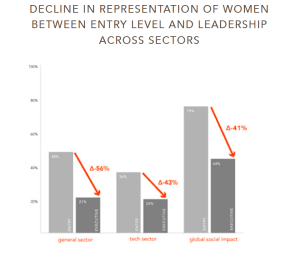
As development professionals, we understand how critical it is to engage women to solve the world’s greatest problems. Want to educate a child? Engage mothers. Want to reduce infant mortality? Educate a girl. Want to increase household incomes? Give women access to financial institutions. This is why gender equality is such a critical piece of the Sustainable Development Goals and why so many development organizations include the empowerment of women in their mission statements.
But, do we effectively practice what we preach when it comes to our own teams? Quantum Impact spent the past year answering this question. Today, we’re proud to release our first report titled Realizing Diversity, Accelerating Impact.
As part of this report, our researchers — including principal investigator Dr. Michelle Sandhoff — examined the representation of women on leadership teams and board of directors at headquarter offices for international development organizations. Our report also looked at the representation of underrepresented minorities on leadership teams and board of directors.
Global development and women’s leadership

Through our research, we found that two out of three organizations working in the international development sector do not have headquarter leadership teams that are gendered balanced.
In our sample, we also found that a surprising one out of five organizations do not have any women serving on their leadership teams.
When we looked at boards of directors, we found that four out of five organizations had boards that are not gendered balanced.
Finally, we took a high-level look at how the international development sector as a whole compares against other sectors, such as the tech industry. When we looked at just women at leadership levels, international development appeared to be doing okay. After all, Quantum Impact’s report found that 44 percent of leaders across the sector are women. In tech, only 20 percent of leadership positions are held by women.
But, then we compared the percentage of the workforce that is female at entry-levels versus the percentage of leadership that is female. When we did that, we found that international development is actually not doing so well. For example, in tech, there is a 43 percent decline of women from entry-level to leadership levels; in international development, it’s a 41 percent decline. The reason? International development has a much larger female entry-level workforce than other sectors.

What does this mean? It means there is indeed a glass ceiling in international development. This finding also suggests that the international development sector also suffers from the systemic barriers that affect women in other sectors, such as barriers around promotion, the prevalence of micro and macro aggressions, lack of mentorship and career sponsorship for women, and other factors. Read the full report at www.quantumimpact.org, including our findings about leaders of color.
Why does a gender gap in leadership matter?
This matters for a few reasons. First, research in other sectors has shown us that diverse and inclusive teams help organizations perform better, retain more talent, and bring more innovative solutions to the table. We believe this also holds true for international development. Research has also shown that diverse boards of directors help organizations bring in additional insights and ideas, raise more money, and ultimately achieve better results.
In short, we argue that diverse and inclusive international development organizations, specifically those with more women in leadership positions, will have greater development impact.
Second, in the aftermath of the Oxfam sexual abuse scandal and the #MeToo movement, it’s critical for us all to work together to make our offices safe for all staff, and to ensure that teams are not causing harm in the communities in which we work. Research has shown us that organizations that have women in leadership positions help to prevent organizational cultures that allow widespread abuse to happen under the guise of “boys will be boys.” This is one factor that can lead to a reduced sexual harassment and sexual abuse in offices.
Finally, female leadership is a core part of us living our values. Imagine this from the perspective of a key stakeholder. You are working with a development implementer on a program to empower women, education girls, include women in decision-making, etc. You are curious to learn more, so go to the organization’s website and look up executive team... and find it’s mostly men (and mostly white). Would you trust this organization to be the technical advisors to help empower women or reach gender parity, when the organization can’t do that on their own team? Our credibility as development implementers requires us to practice what we preach.
What can organizations do?
The simple answer is: We need more women at the top. We at Quantum Impact recommend that organizations take the following steps to help address this critical imbalance.
1. Use data: As development practitioners, we understand the importance of establishing a baseline and using data to help make evidence-based decisions. Organizations can conduct internal diversity audits to establish baselines that measure gender parity in the various career levels to identify the size of the gender leadership gap. The baseline is critical in order to set targets, identify problem areas, and strategize solutions.
2. Focus on changing culture, not just one-off trainings: No single factor has solely led to this gender gap; and no one solution will solve it. That is why we recommend that organizations develop holistic diversity and inclusion strategies that address a wide range of factors. These strategies can and should include some training, but should also incorporate changes to policies, processes, and systems such as blind resume reviews to reduce recruitment biases, revised performance evaluation systems to reduce barriers to promotion, and systemic changes to how salary negotiations are conducted.
3. Look beyond recruitment: Our research also indicates that there are issues at every point in a woman’s career in international development, from the hiring process at her first entry-level position through her promotion for tenure on a board. As such, we recommend that organizations work along every point in a person’s career journey — including, but not limited to — recruitment, retention, and promotion.
We also call upon funders and donors to specifically require that organizations seeking funds to work on gender empowerment have gender-balanced teams, both in the field but also in their headquarters. If an organization is unable to operationalize their commitment to women’s empowerment in their own offices, how can you trust them to do this critical work overseas with vulnerable populations?
Finally, we recommend that individuals engage in the diversity discussion. One easy thing that all of us can do is to generate data — by using websites such as Glassdoor or InHerSight — that will help us all make more informed decisions about where we choose to work. We can also all take ownership of our own leadership skills, including taking individual steps to diminish unconscious bias and build more inclusive teams.
Update, March 9, 2018: This article has been updated to clarify that in the author’s sample, four out of five organizations had boards of directors that were not gendered balanced.









